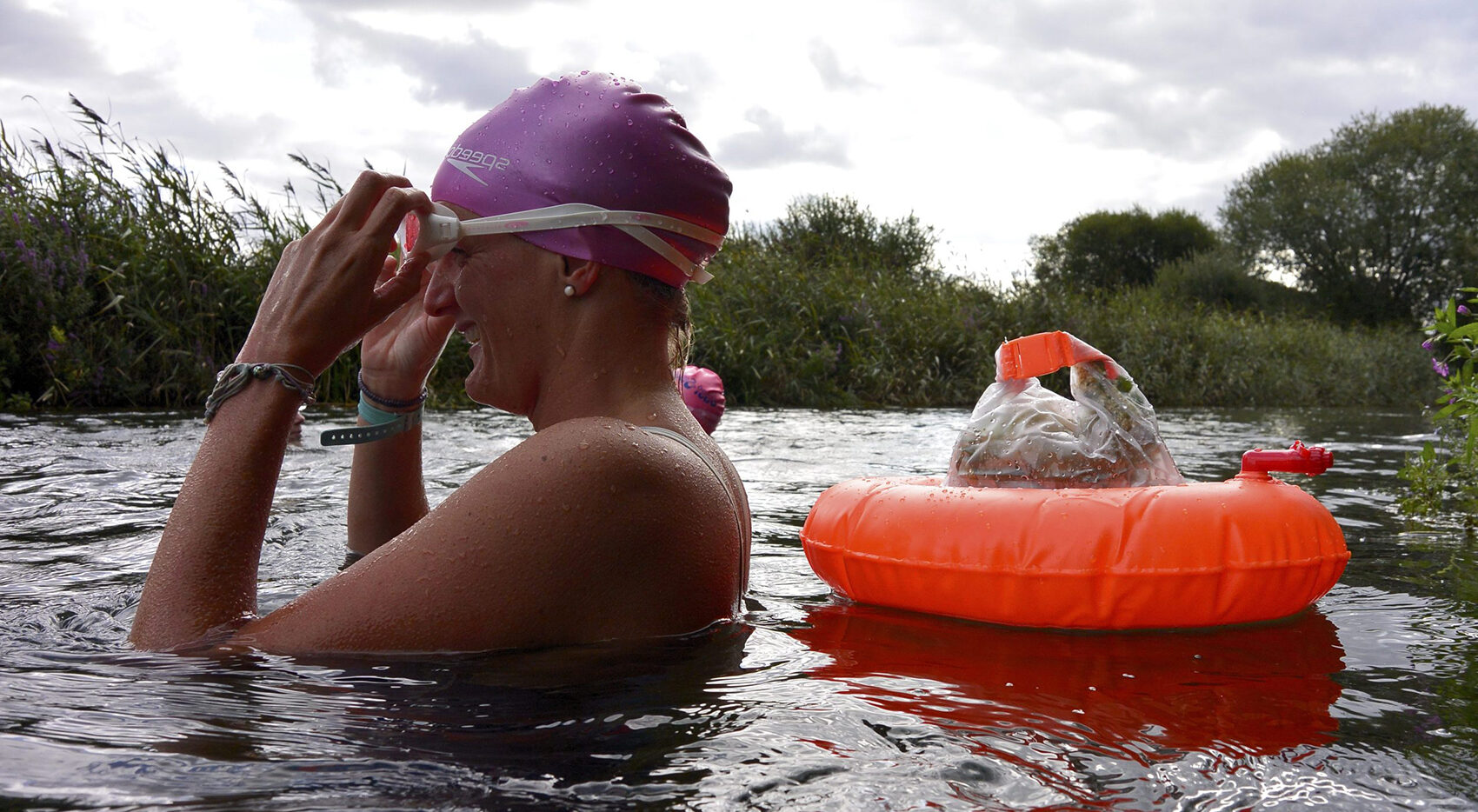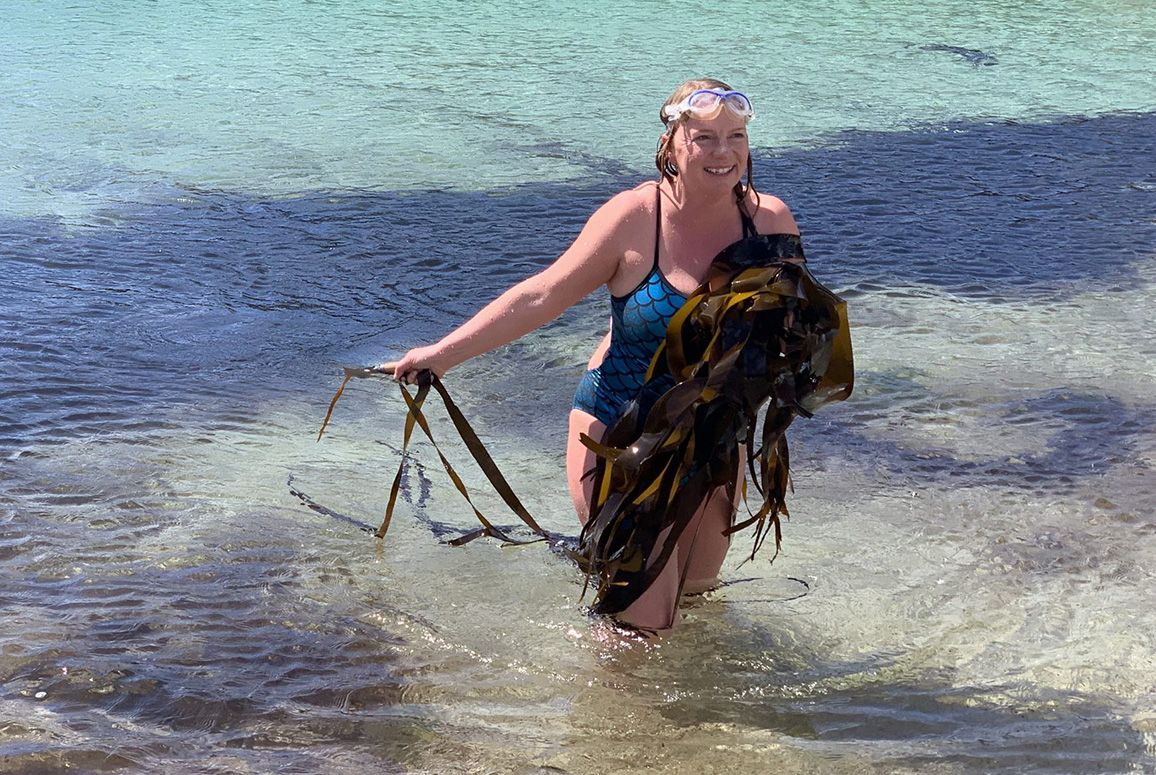
I’ve spent years gathering wild ingredients from the edges of rivers, lakes and seas. Sometimes it’s a handful of water mint and meadowsweet tucked between two swim caps to make a fragrant tea. Sometimes it’s sugar kelp wrapped around my swimsuit to cook over coals. For me, swimming and foraging go hand in hand: a way of moving through place and time with all the senses alert.
While I now work as an ethnobotanist, studying the relationships between people and plants, my interest in foraging began long ago. Childhood summers in Switzerland were spent swimming in lakes and picking berries. At our favourite lake, where flecks of peat swirled in the dark water like tea leaves in a pot, wild bilberries dappled the shoreline. Tiny and delicate, we ate the perfumed fruits on the spot. Their purple juice washed off our hands as we swam back.
Sometimes it’s a handful of water mint tucked between two swim caps. Sometimes it’s sugar kelp wrapped around my swimsuit to cook over coals.
Over the years, swimming has become another way into this world. While developing the Isle of Harris Gin, I wanted to find a flavour that captures the island’s spirit. We experimented with flowering plants, such as silverweed, lady’s bedstraw and bog myrtle, but it was while swimming in the cold Atlantic that I settled on sugar kelp – sustainable, hand-harvested, with a gentle sweetness, evoking the historic importance of seaweed to the island.
Through the seasons, I gather different ingredients – some as simple as a handful of mint for tea, others the starting point for new cocktails and slow-cooked feasts. Here are some of my favourites, season by season.
Water mint – Mentha aquatica
Fresh sprigs of water mint appear in spring. Often detected as you stand at the water’s edge and inadvertently crush its leaves, this is the mintiest mint that grows wild. You are unlikely to confuse it with pennyroyal (Mentha pulegium), a rare plant in the UK, best looked at and not consumed, not only due to its rarity but also because it is hepatoxic. Enjoy water mint or corn mint (Mentha arvensis) as a hot tea or in a mint julep whisky cocktail. Water mint makes great mint sauce, and dropping a few sprigs with a pat of butter on potatoes makes a simple food fragrant.
Watercress – Nasturtium officinale
Watercress is a leafy green that flourishes in spring and turns bitter once it starts to flower in the summer months. Be careful where you pick watercress: it tends to grow among other lush waterside plants. Mistaking hemlock water dropwort (Oenanthe crocata) for watercress can be a fatal move. Watercress is also a host for liver fluke parasites. These are killed by heat, so if you eat foraged watercress, perhaps stick to using it in soup or dishes where it is cooked. If you are a juicing fanatic, add watercress for a bright green colour and sharp kick. If you’re looking for an easy way to taste watercress, try Twisted Nose, which is made at the edge of a chalk stream-fed watercress bed.
Mistaking hemlock water dropwater for watercress can be a fatal move.
 Watercress
Watercress
Marsh Samphire – Salicornia species
Putting on growth in the summer, marsh samphire is a juicy and slightly salted bite. Not at all related to rock samphire, this is another waterside plant that has made it into gins, including Conker and Gin Mare. You will often find marsh samphire around estuaries and muddy shores. You’ll need scissors to collect it: pulling the plant will either uproot it, which is illegal unless you have the landowner’s permission, or send you tumbling to the ground. A couple of sprigs make the perfect edible garnish for a martini. It is also an easy vegetable to cook: just blanch in boiling water and serve with a little butter to melt; no need to add salt.
A couple of sprigs make the perfect edible garnish for a martini.
Meadowsweet – Filipendula ulmaria
Unlike the fleeting elderflower season, meadowsweet keeps putting up fresh flowers as summer slips into autumn. Growing in damp patches of meadows and often in abundance along riverbanks, creamy flowerheads of meadowsweet offer a bewitching sweet almond aroma. If you dry these delicate petals for later use, ensure they dry fast, either in a dehydrator or on warm, sunny days, as, when dried in damp conditions, they are prone to toxic mould. Meadowsweet flowers can be used fresh or dried in cold cocktails and cordials, blending well with citrus peel and berries. You can also use them to make fragrant hot tea, perhaps with a splash of rum.
Sea sandwort – Honckenya peploides
Growing in dense, succulent carpets on seashores, sea sandwort is unmistakable for its cucumber and pea shoot aroma, released if you lean against it while picking a few stalks. Bitter when flowering in midsummer, the time to collect sea sandwort is in spring or autumn when there’s a second flush of growth. Don’t be tempted to pull up its roots, which run through the sand, stabilising seashores. Cut off the upper parts of stalks and rinse well to get rid of any sand. The chunky structure is ideal for making pickles: fill a jar with sandwort and pour over a pickle liquid of vinegar, water, sugar and salt.
Channelled wrack – Pelvetia canaliculata
On autumn days, channelled wrack glows in the low sun. A common seaweed that grows on rocks exposed at low tide, channelled wrack is tough enough to survive out of water. The trick is to blanch fresh tips in boiling water before serving them in salad.
Kelps – Laminaria species
As the sea temperature cools, many kelps surge into active growth. While working as an ethnobotanist for the Isle of Harris Distillery, I selected sugar kelp (Laminaria saccharina) as the key ingredient, as it combines the social and economic history of the island with a soft, oceanic flavour. Yes – sugar kelp does taste a little sweet.
Sugar kelp, oarweed (Laminaria digitata) and cuvie kelp (Laminaria hyperborea) can be used to make your own dashi, a Japanese stock, the foundation of miso, or a hot savoury drink. While Japanese dashi doesn’t use our native seaweeds, our kelps have the same umami depth. Long blades of sugar kelp are ideal for wrapping fish, meat and vegetables before cooking over coals to keep them succulent and clean of ash.
Growing in relatively shallow waters, it is only a duck-dive down to cut kelp fronds, leaving their holdfasts to regrow. A band of sugar kelp is easy to hold while swimming. Bulky oarweed or cuvie kelp are more awkward: try wrapping around a swimsuit strap.
Rock Samphire – Crithmum maritimum
Even in the depths of winter, evergreen rock samphire can be picked. Always growing near the seashore, rock samphire is a concentrated burst of flavour. In the UK, rock samphire used to be collected for pickling but the habit has died out. In Istanbul, you can still see rock samphire in greengrocers and pickle shops. Rock samphire is versatile: taste it bottled in flavoured gins or pick your own to pickle in brine. You can use rock samphire brine in a pickleback to chase a shot of whisky or add a bowl of picked rock samphire to a spread of meze or a ploughman’s lunch.
A band of sugar kelp is easy to hold while swimming. Bulky oarweed or cuvie kelp are more awkward: try wrapping around a swimsuit strap.
 Susanne collecting sugar kelp
Susanne collecting sugar kelp
My favourite foraging book remains Wild Food: A Complete Guide by Roger Philips. My dad picked this up while rummaging in a book sale over 30 years ago. Little did he know that wild plants would become my job.
If you would like more guidance on getting to know plants, you can use the Association of Foragers’ Directory to find courses near you. There is more information on foraging in my book Wild Waters – a guide to waterside wildlife in Britain and Ireland.